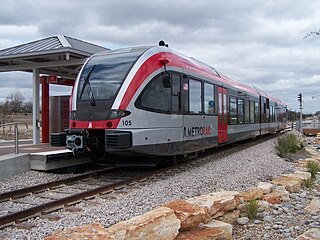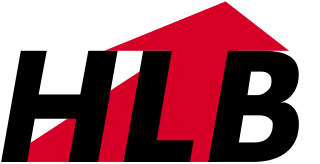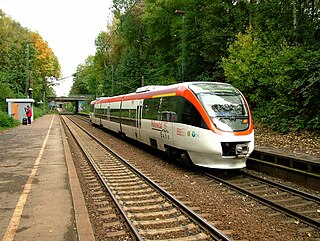| DWA LVT/S | |
|---|---|
 |
DWA LVT/S is a diesel multiple unit for regional traffic with low-floor entry.
| DWA LVT/S | |
|---|---|
 |
DWA LVT/S is a diesel multiple unit for regional traffic with low-floor entry.
In 1996, Deutsche Waggonbau designed the double-decker DBAG Class 670, which, however, did not satisfy its operational requirements. As an alternative, the DWA developed the single-deck railcar LVT/S (DBAG Class 672), which was designed to be more robust and suitable for full-track use. With the acquisition of DWA by Bombardier Transportation a further construction was omitted as well as an extension of the vehicle range to a control car or a twin-railcar variant.

In 1998, some vehicles were used by the Butzbach-Licher Eisenbahn on the Friedberg-Friedrichsdorf railway line because the ordered GTW 2/6 could not be delivered on time.
19 vehicles have been used by the Burgenlandbahn in Saxony-Anhalt since 1999 (as of 1 July 2008). [1] The vehicles are stationed in Weißenfels.
Originally the vehicles were called KEG VT 3.01 to VT 3.18. Since the takeover of the vehicles by DB Regio in the year 2004 they are listed as 672 series. In the inventory there are the vehicles 672 901 to 904, 906 to 911 and 913 to 920. 672 912 is parked after a fire [2] and 672 905 was retired on 27 November 2014. [3] From April 2006 to December 2006, the vehicles were not used because of a damage of the frame for safety reasons until their renovation. Since March 2012, 672 919 and 920 have been stored as pre-production models. They have solid shafts for which there are no test instructions that meet the requirements of the Federal Railway Authority (EBA).
Due to a redesign of the VT 2E of the Frankfurt-Königsteiner Eisenbahn (as well as the Butzbach-Licher Eisenbahn, a subsidiary of the Hessische Landesbahn), three units of this type were used from 2006 to 2007 on the Königsteiner Bahn. These came from Bombardier and were on loan. In the meantime, they belong to the Hanseatische Eisenbahn.
In December 2011, the Städtebahn Sachsen rented a vehicle from Bombardier, which was mostly used between Pirna and Neustadt in Sachsen. In the meantime, the vehicle has been repainted and operates since December 2012 on the lines won by the Eisenbahngesellschaft Potsdam in the Prignitz.

The Talent is a multiple unit railcar manufactured by Bombardier that was developed by Waggonfabrik Talbot in Aachen shortly before the company was acquired by Bombardier in 1995. The name Talent is an acronym in German for TALbot LEichter Nahverkehrs-Triebwagen.

Alstom Traxx is a modular product platform of mainline diesel-electric and electric locomotives produced originally by Bombardier Transportation and later Alstom, which was built in both freight and passenger variants. The first version was a dual-voltage AC locomotive built for German railways from the year 2000. Later types included DC versions, as well as quadruple-voltage machines, able to operate on most European electrification schemes: 1.5/3.0 kV DC and 15/25 kV AC. The family was expanded in 2006 to include diesel-powered versions. Elements common to all variants include steel bodyshells, two bogies with two powered axles each, three-phase asynchronous induction motors, cooling exhausts on the roof edges, and wheel disc brakes.

The Class 425 and Class 426 EMUs are a class of electric multiple units built by a consortium of Siemens, Bombardier and DWA, and are operated by DB Regio in Germany. They are essentially the same vehicle design, but the Class 425 EMU consists of four carriages, whereas the Class 426 EMUs only have two carriages.

The Stadler GTW is an articulated railcar for local transport made by Stadler Rail of Switzerland. GTW stands for Gelenktriebwagen.

The Bombardier Double-deck Coach is a bilevel passenger railcar currently manufactured by Alstom, which acquired Bombardier Transportation in 2021 used by various European railways and Israel Railways. The current generation of double-deck coaches can be run at speeds up to 200 km/h (125 mph). Depending on their configuration, each coach can seat 100 to 150 passengers.

DBAG Class 411 and Class 415 are German tilting electric multiple-unit high-speed trains in service with DB Fernverkehr, commonly known as ICE T.
The Stadler Regio-Shuttle RS1 is the first widely used, new-generation, diesel railcar in Germany and Czech Republic for local railway services. Its most characteristic feature is the trapezium-shaped window frames. The Regio-Shuttle is classified by the Deutsche Bahn as Class 650, by the České Dráhy as Class 840 or Class 841, however numerous private railways have their own Regio-Shuttles.

The DB Class 628 is a twin-car, diesel multiple unit operated by the Deutsche Bahn for local passenger rail services.

The DR 130 family of locomotives comprises the DR Class 130, DR Class 131, DR Class 132 and DR Class 142, in USSR locomotive called TE109 and TE129.

The DBAG Class 145 and DBAG Class 146 are Bo′Bo′ mainline electric locomotives built by Adtranz primarily for the Deutsche Bahn at the end of the 1990s. The Class 145 is the freight version for DB Cargo; the Class 146 is the passenger version for DB Regio. Additional freight machines were built for the former Swiss railway Mittelthurgaubahn as well as for various private operators and leasing companies.

128 001, as registered at Deutsche Bahn, or 12X, as named by its manufacturer AEG Schienenfahrzeuge and its successive owners ADtranz and Bombardier Transportation, is an experimental high-performance electric locomotive built in 1994, which was operated as testbed and test locomotive until 2010. The design of the locomotive featured several technological innovations, including power electronics using new types of semiconductors and water cooling, a new final drive concept, a new bogie concept, and protruding windflaps for improved aerodynamics that gave the locomotive a unique look.

The Sieg Railway (German: Siegstrecke is a 100-kilometre long, electrified German main line railway between Cologne-Deutz via Porz, Troisdorf, Siegburg, Hennef, Au, Betzdorf to Siegen with a through service to Cologne Hauptbahnhof. Although most of it is two-track, two five-kilometre sections are only single track. Both ends of the line are in the state of North Rhine-Westphalia, but between Au and Niederschelden it runs through Rhineland-Palatinate. It is one of the oldest lines in Germany, opened between 1859 and 1862 by the Cologne-Minden Railway Company.

The Class 430 EMU is an electric railcar for S-Bahn commuter networks in Germany, jointly developed by Bombardier and Alstom. The first trains went into service in 2012, replacing the Class 420 EMUs of the Stuttgart S-Bahn.

Nidda station is a station on the Gießen–Gelnhausen railway in the town of Nidda in the German state of Hesse. It is also at the end of the Beienheim–Schotten railway from Friedberg station. The station is classified by Deutsche Bahn (DB) as a category 4 station.

Hessische Landesbahn is a regional transport company owned by the German state of Hesse, based in Frankfurt am Main. It provides bus and rail passenger transport services and, to a lesser extent, rail freight services in Hesse and across the state’s borders through its subsidiaries and affiliates.
The Kassel-based Kurhessenbahn (KHB) is the first of six regional networks to be created by Deutsche Bahn AG as part of its middle class offensive. It forms a unit that is formally split into DB RegioNetz Verkehrs GmbH and DB RegioNetz Infrastruktur GmbH in order to comply with the legal requirements after separation of network and operations.
The Burgenlandbahn is a brand that DB Regio uses for their local passenger rail transport in southern Saxony-Anhalt, Germany. Since 1999, it has served several branch lines, some of them have been canceled in the meantime. With the Burgenlandbahn great hopes were combined to secure the area network by low operating costs despite low population density permanently.
Hanseatische Eisenbahn GmbH (HANS) is a rail transport company that emerged in 2014 from the passenger transport division of Eisenbahngesellschaft Potsdam (EGP). Both companies belong to ENON GmbH, which is based in Putlitz in the northwest of Brandenburg, Germany.

The Westfrankenbahn is a RegioNetz of the Deutsche Bahn AG based in Aschaffenburg.

The Dortmund-Märkische Eisenbahn GmbH (DME) was a German train operating company, that operated the Dortmund–Hagen–Lüdenscheid train service from 30 May 1999 to 11 December 2004. It was a subsidiary of the Dortmunder Stadtwerke (74%) and the Märkische Verkehrsgesellschaft (26%), the municipal public transport operators of Dortmund and Märkischer Kreis.